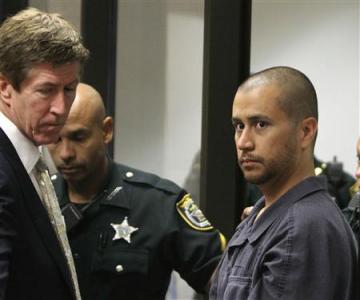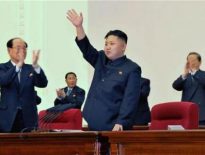(Reuters) – A handcuffed George Zimmerman, charged with killing
unarmed black teenager Trayvon Martin, appeared in court for the first time on Thursday and his lawyer said a not guilty plea
was entered on his “frightened” client’s behalf.

The neighborhood watch volunteer’s lawyer, Mark O’Mara, also said he wanted Zimmerman to be
released on bond, but not until he could secure a safe place for him to stay while he faces murder charges in the February 26
killing of 17-year-old Martin in a quiet gated community in the central Florida town of Sanford.
Zimmerman, hands
shackled, head shaved and wearing a close-clipped goatee, addressed a judge via teleconference from the John E. Polk
Correctional Facility. He said “Yes sir” twice during the five-minute hearing in a small jailhouse courtroom.
Judge
Mark Herr set formal arraignment for May 29 and agreed to seal some of the case file.
“It was a very standard
procedure. A not guilty plea was entered. We have an arraignment set for the 29th. We’ll attend to a bond motion between now
and then,” O’Mara told reporters after the hearing.
He said he chose not to ask for bail immediately because it might
“only arouse the fervor” around the case.
Zimmerman, 28, whose father is white and mother Hispanic, has received death
threats and was in hiding for weeks. Arrested Wednesday, he could face life in prison if convicted.
His booking sheet
listed him at 5’10” and weighing 185 lbs. (84 kgs), with two tattoos, one of theatrical masks on his left arm and one with
the name “Christina” inside a cross on his chest.
For his protection, Zimmerman has been segregated from the general
prison population in a roughly 67-square-foot cell with a toilet and two beds, according to the local sheriff’s office. The
correctional facility where he spend his first night on Wednesday, after surrendering to authorities in Jacksonville,
Florida, holds about 1,000 other inmates.
“He’s facing a second-degree murder charge now,” O’Mara said. “He’s
frightened. That would frighten any one of us.”
The killing of Martin more than six weeks ago has set off a furious
debate about race relations and self-defense laws, punctuated by a series of demonstrations across the country.
Even
U.S. President Barack Obama commented on the case, saying, “If I had a son, he would look like Trayvon.”
The shooting
initially received scant local media attention and went unnoticed nationally, but as Martin’s parents and lawyers made
public calls for Zimmerman’s arrest a firestorm of media coverage and celebrity tweets ensued.
A Reuters/Ipsos poll
on Thursday showed Americans deeply divided over the Martin case, with 91 percent of blacks but only 35 percent of whites
saying he was unjustly killed.
Martin’s mother accused Zimmerman, a neighborhood watch volunteer, on Thursday of
having “stalked my son and murdered him in cold blood,” and clarified earlier comments in which she referred to the killing
as an accident.
“The ‘accident’ I was referring to was the fact that George Zimmerman and my son ever crossed paths.
It was an accidental encounter,” she said in a statement.
“If George Zimmerman hadn’t gotten out of his vehicle, this
entire incident would have been avoided.”
‘HORRIBLE INTERCEPTION’
Asked about the mother’s use of the word
“accident,” and how it might affect the case against his client, O’Mara, who noted that he had not seen any evidence yet,
seemed unsurprised.
“I look forward to having a conversation with her to see exactly what her feelings are,” he said.
“Obviously it was a horrible interception of two young men’s lives and it ended in tragedy,” he said. “We have to figure out
how it happened, why it happened and who might be responsible for it.”
The encounter began when Zimmerman called
police to report what he called “a real suspicious guy” and then followed Martin against the advice of a police
operator.
What transpired next, resulting in what O’Mara described as “a deceased child,” is the subject of intense
debate.
But in an affidavit of probable cause submitted to the court, two investigators assigned to the case by
special prosecutor Angela Corey reported that Zimmerman “disregarded the police dispatcher” who instructed him not to follow
Martin and then confronted him until “a struggle ensued” that ended with Martin’s death.
The affidavit also states
that Martin was “profiled” by Zimmerman, despite the fact that he was “unarmed and was not committing any crime.”
A
bullet casing recovered at the scene of the killing was determined to have come from Zimmerman’s handgun, the court filing
said.
It said “witnesses heard numerous calls for help and some of these were recorded in 911 calls to police. Trayvon
Martin’s mother has reviewed the 911 calls and identified the voice crying for help as Trayvon Martin’s
voice.”
Zimmerman and his supporters have offered a different account, including about whose voice can be heard crying
for help. Zimmerman told police Martin attacked him, decking him with one punch to the nose.
Martin then repeatedly
slammed Zimmerman’s head against a concrete walkway, Zimmerman’s brother and father have said. Zimmerman then pulled out
the 9mm handgun he was licensed to carry and shot Martin once in the chest.
Critics called Zimmerman’s account into
question when surveillance video of Zimmerman being taken to the police station revealed little in the way of apparent
injuries.
Authorities initially declined to arrest Zimmerman, citing Florida’s “Stand Your Ground” law, which allows
people to use deadly force when they believe they are in danger of getting killed or suffering great bodily
harm.
Thousands of people demonstrated in rallies in Sanford and around the country, demanding Zimmerman’s arrest and
criticizing the police. Civil rights activists say racial prejudice played a role in Zimmerman’s view that Martin looked
suspicious and in the police decision not to arrest him.
O’Mara noted that a small percentage of murder cases go to
trial, with many resolved in a plea bargain. “We’re not taking any possibilities off the table how this case gets resolved.
I haven’t seen the first sheet of evidence yet so it’s very premature,” he said.
(Writing by Dan Burns and Paul Thomasch; Editing by Tom
Brown and Todd Eastham)





